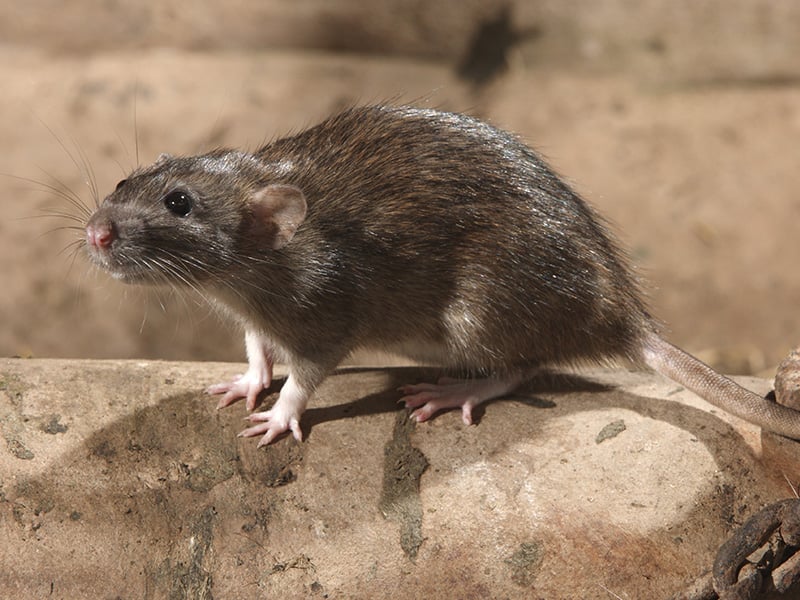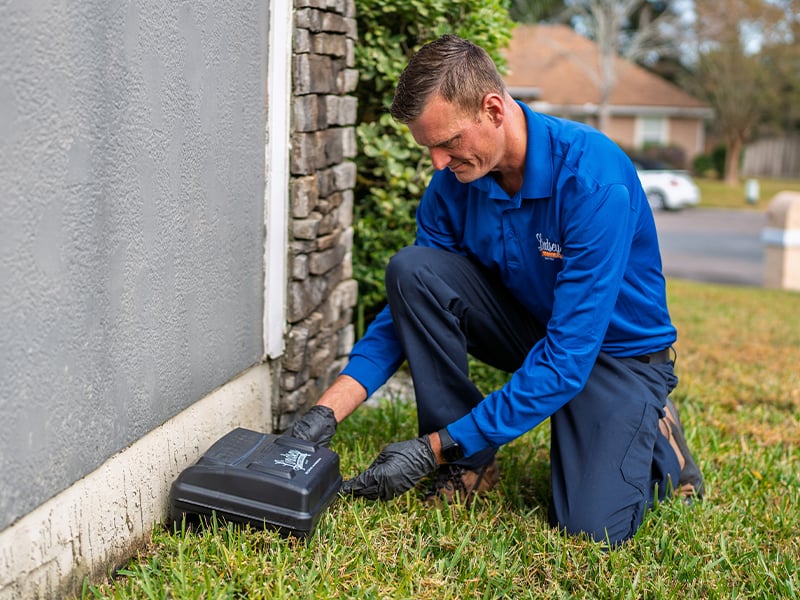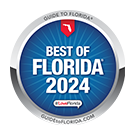What do Norway rats look like?
Norway rats, also known as sewer rats or brown rats, are large, heavy-bodied rats with shaggy brown to gray-colored fur. Their underbelly is covered in lighter gray to whitish-colored fur. They have small, beady eyes, small ears, blunt noses, and a long scaly tail without hair. An adult Norway rat's body grows to about 9 ½ inches, and their tail adds another 6-8 inches. These rats are good swimmers, but their dense bodies prevent them from being great climbers.

When are Norway rats most active?
What do Norway rats eat?
Norway rats eat a varied diet of fruits, meats, nuts, and grains. Any property that offers them places to forage for their favorite foods will attract Norway rats. Trash cans, compost piles, gardens, and pet food bowls are places where these rodents forage for food.
Where do Norway rats nest?
Norway rats like to create burrows in sheltered areas near food sources. Common burrowing sites in or near Jacksonville and Northeast Florida homes and businesses include:
-
Crawl spaces
-
Behind walls
-
Basements
-
Under foundations
-
Woodpiles
-
Construction debris
-
Sheds
-
Garages
-
Garden areas
-
Soil along riverbanks
Are Norway rats dangerous?
Norway rats are dangerous pests for several reasons. They can contaminate food, food preparation areas, and other surfaces with their saliva and excrement, potentially spreading diseases such as Hantavirus, Leptospirosis, rat-bite fever, and Salmonella.
As rodents, Norway rats have continuously growing front incisors on their top and bottom jaw, so they constantly chew on objects to prevent overgrowth. This behavior can cause significant damage to wires, pipes, insulation, walls, floors, furniture, clothing, and more.
Additionally, Norway rats leave grease marks on walls and furniture as they have poor eyesight and use walls and furniture as a guide to navigate from food sources to their nest.
How do I get rid of Norway rats?
The best way to eliminate Norway rats is to contact a professional pest control company. At Lindsey Pest Services, we've provided effective rodent control for homes and businesses since 1957, and have the experience to eliminate these destructive pests, whether you have a couple of rats or a full-blown infestation.
We also offer home pest control plans that not only target common house-infesting insects, but rodents as well! Check out our Better Plan below or reach out for assistance.
Better Pest Control Plan "Our Most Popular Plan!"
Starting at only $59* per month, Lindsey's Better plan protects your home and family from over 30 general pests plus rodents. This residential pest control plan includes an initial interior and exterior inspection and treatment for your existing pest problem. After the initial service, an experienced technician will return every quarter to perform an exterior treatment to keep insects and rodents out.
-
Quarterly Pest Service
-
Lindsey Pest Free Guarantee
-
30+ Common Pests
-
Webbing Removal (Up to 12 ft)
-
Wasp Removal (Up to 10 ft)
-
Rodent Control
-
Seasonal Mosquito Suppression
-
Fire Ant Control
-
Scorpion & Other Stinging Insect Control
Pests Covered In This Program:
German Cockroaches, American Cockroaches, Brown Banded Cockroaches, Australian Cockroaches, Asian Cockroaches, Woods Roaches, Carpenter Ants, Pharaoh Ants, Rover Ants, Ghost Ants, Thief Ants, Monomorium Ants, Acrobat Ants, Big-Headed Ants, Odorous House Ants, Pavement Ants, Little Black Ants, Silverfish, Fire Brats, Springtails, Psocids, Polistes Wasps, Crickets, Earwigs, Cellar Spiders, Jumping Spiders, Weevils, Cigarette Beetles, Drugstore Beetles, Confused Flour Beetles, and Fungus Gnats PLUS Rodents
Additional Details
* New customers only - after initial fee. Some exclusions may apply.
* One year service agreement required
* Early cancellation fee may apply

Get Your Free Pest Control Quote Today!
Complete the form below to get started with your free, no-obligation quote, and a Lindsey Pest representative will contact you shortly.
Same Day Service Available!









